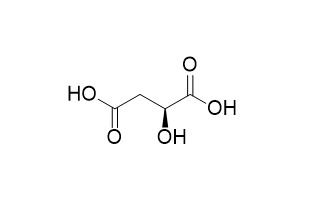L-(-)-Malic acid
Reference standards.
Inquire / Order:
manager@chemfaces.com
Technical Inquiries:
service@chemfaces.com
Tel:
+86-27-84237783
Fax:
+86-27-84254680
Address:
1 Building, No. 83, CheCheng Rd., Wuhan Economic and Technological Development Zone, Wuhan, Hubei 430056, PRC
Providing storage is as stated on the product vial and the vial is kept tightly sealed, the product can be stored for up to
24 months(2-8C).
Wherever possible, you should prepare and use solutions on the same day. However, if you need to make up stock solutions in advance, we recommend that you store the solution as aliquots in tightly sealed vials at -20C. Generally, these will be useable for up to two weeks. Before use, and prior to opening the vial we recommend that you allow your product to equilibrate to room temperature for at least 1 hour.
Need more advice on solubility, usage and handling? Please email to: service@chemfaces.com
The packaging of the product may have turned upside down during transportation, resulting in the natural compounds adhering to the neck or cap of the vial. take the vial out of its packaging and gently shake to let the compounds fall to the bottom of the vial. for liquid products, centrifuge at 200-500 RPM to gather the liquid at the bottom of the vial. try to avoid loss or contamination during handling.
Processes2021, 9(11),2065.
Applied Biological Chemistry2022, 65(85).
Phytother Res.2015, 29(7):1088-96
Anal Bioanal Chem. 2016, 408(15)
BioRxiv-The Preprint server for biology2023, 586957.
Horticulture Research2022, uhac276.
Molecules.2022, 27(2):451.
Phytomedicine.2023, 120:155063.
J Med Food.2021, 24(2):151-160.
Nutrients.2021, 13(12):4364.
Related and Featured Products
Journal of Agricultural & Food Chemistry, 2007, 55(3):912.
l -(−)-Malic Acid Production by Saccharomyces spp. during the Alcoholic Fermentation of Wine (1).[Reference:
WebLink]
METHODS AND RESULTS:
In an attempt to increase the acidity of wine by biological means, malate-producing yeasts were selected from a collection of 282 strains isolated in different parts of Spain. Only 4% of these strains (all of which belonged to Saccharomyces cerevisiae) produced L-(-)-Malic acid in the range of 0.5-1 g/L. This was formed between days 2 and 6 of alcoholic fermentation, reaching a maximum on days 3 and 4; the concentration remained stable from day 7. Malic acid production was favored by temperatures in the 18-25 degrees C range and by musts with a high pH and low concentrations of sugar, initial malic acid, and yeast-assimilable nitrogen.
CONCLUSIONS:
Oxaloacetic acid, a precursor of malic acid, had no influence on malate production. The precursors pyruvic and fumaric acid did, however, have a significant effect on the production of this acid in some strains. No direct relation between pyruvate and malate metabolism was observed.



